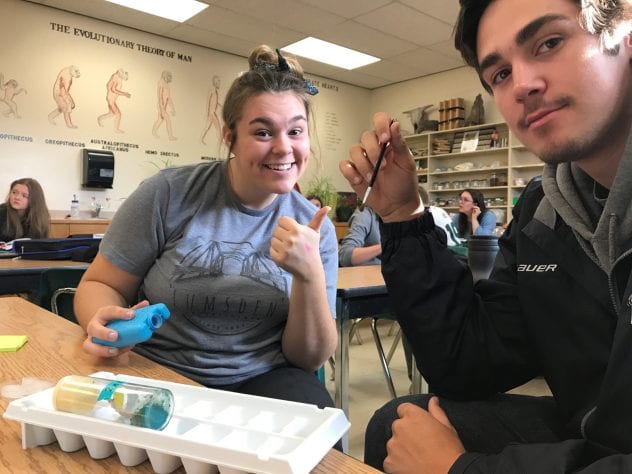 By Carla Cooper (High School Biology Teacher, MEd Student – Curriculum and Instruction at the University of Regina)
By Carla Cooper (High School Biology Teacher, MEd Student – Curriculum and Instruction at the University of Regina)
Think back to the last time you played. I mean, really played. What were you doing? How were you feeling? Where were you? There were so many lessons learned during that play. Lessons that we have carried forward with us. I teach high school science a bit differently than most teachers do. I don’t stay “in” a box – in fact, I would describe myself as walking a wide parameter around the traditional box. Upon entering my room students get their first glimpse of just how different this class will be compared to others. I don’t have my classroom set up in the traditional rows – we sit in conference sections; there are five in my room. There is an encouragement of collaboration, communication, creativity, character, critical thinking and citizenship (New Pedagogies for Deep Learning)
We need to get kids back into the sandbox – to use their imaginations, problem-solving skills, communication skills and have them collaborate as they did when they were toddlers playing. If we allow this to happen, we are then able to ask deeper questions of our students – having them think deeper and critically. How do I attempt to do this? I teach science with a story. For example, in Biology 30 – my students are welcomed into the classroom and it is quickly explained to them that they are Jurassic World lab technicians this semester. 
My entire course is based on Jurassic World (both the first and second one). We begin the semester by reading the prologue to Jurassic Park and then dive right into watching Jurassic World. Jurassic World actually supports every outcome in our curriculum (no the curricula wasn’t written with this in mind, this is just how I teach it). In Health Science 20, the students are put into resident groups (think Gray’s Anatomy) and need to take care of patients throughout the semester. The final is based on how well they diagnosed, treated, were ethical, and understood the human body of their patients. No written final in this class (I am accredited and have this option) – rather, the students completed a “patient rounds” presentation – did their patient live or die and why? In Environmental Science 20, my students are world travelers. In Science 10, my students are engineers; however, this one is still in the developmental stage.
I believe that by letting the students take on a role in the class (lab technicians, doctors, world food educators, etc) the students take the class more seriously and bite into the content of the course. We borrow equipment from the University of Regina to practice sophisticated biotechnology, we Skype a Scientist to discuss our what we are currently learning about, we problem solve together, but most importantly, we fail forward as we learn through digging deeper into the content as we peel back the layers and revert back into the “sandbox”.
I teach high school in Lumsden, a small Saskatchewan rural community. I am also a graduate student at the University of Regina, concentrating on Curriculum and Instruction. In 2012, I had the unique opportunity of writing a new curriculum for the Ministry of Education in Saskatchewan. And by new, I mean that this curriculum did not exist before we began writing it. In Saskatchewan, we no longer have Biology 20, Chemistry 20, and Physics 20. Rather, we now have Health Science 20, Physical Science 20, and Environmental Science 20. The move to these new curricula was the brainchild of our science consultant at the Ministry of Education, Dean Elliott. The new curricula all contain elements of the previous curricula within them. I was on the Health Science 20 curriculum writing team, and have been a support person for the development of Health Science 21 and Environmental Science 21 as well as on the implementation support group where we develop resources to complement the new curricula. It was this opportunity that really taught me about reading and understanding the outcomes and indicators of the curriculum. As we were writing a new course, we needed to be imaginative, practical, constructive, collaborative, and careful with our ideas. This process gave me the confidence to step outside the curricula as written and spread my wings.


